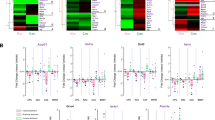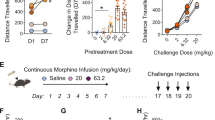Abstract
Morphine produces analgesia by activating mu opioid receptors encoded by the MOR–1 gene. Although morphine–6β–glucuronide (M6G), heroin and 6–acetylmorphine also are considered mu opioids, recent evidence suggests that they act through a distinct receptor mechanism. We examined this question in knockout mice containing disruptions of either the first or second coding exon of MOR–1. Mice homozygous for either MOR–1 mutation were insensitive to morphine. Heroin, 6–acetylmorphine and M6G still elicited analgesia in the exon–1 MOR–1 mutant, which also showed specific M6G binding, whereas M6G and 6–acetylmorphine were inactive in the exon–2 MOR–1 mutant. These results provide genetic evidence for a unique receptor site for M6G and heroin analgesia.
This is a preview of subscription content, access via your institution
Access options
Subscribe to this journal
Receive 12 print issues and online access
$209.00 per year
only $17.42 per issue
Buy this article
- Purchase on Springer Link
- Instant access to full article PDF
Prices may be subject to local taxes which are calculated during checkout






Similar content being viewed by others
References
Pasternak, G. W. Pharmacological mechanisms of opioid analgesics. Clin. Neuropharmacol. 16, 1–18 (1993).
Way, E. L., Young, J. & Kemp, J. Metabolism of heroin and its pharmacological implications. Bull. Narcotics 17, 25–33 (1965).
Way, E., Kemp, J., Young, J. & Grasetti, D. R. The pharmacologic effects of heroin in relationship to its rate of biotransformation. Pharmacol. Exp. Ther. 129, 144–154 (1960).
Oldendorf, W. H., Hyman, S., Braun, L. & Oldendorf, S. Z. Blood–brain barrier: penetration of morphine, codeine, heroin, and methadone after carotid injection. Science 178, 984–986 (1972).
Inturrisi, C. E. et al. The pharmacokinetics of heroin in patients with chronic pain. N. Engl. J. Med. 310, 1213–1217 (1984).
Inturrisi, C. E. et al. Evidence from opiate binding studies that heroin acts through its metabolites. Life Sci. 33 Suppl 1, 773–776 (1983).
Rossi, G., Pan, Y.–X., Cheng, J. & Pasternak, G. W. Blockade of morphine analgesia by an antisense oligodeoxynucleotide against the mu receptor. Life Sci. 54, PL375–379 (1994).
Rossi, G. C., Standifer, K. M. & Pasternak, G. W. Differential blockade of morphine and morphine–6 beta–glucuronide analgesia by antisense oligodeoxynucleotides directed against MOR–1 and G–protein alpha subunits in rats. Neurosci. Lett. 198, 99–102 (1995).
Rossi, G. C., Pan, Y.–X., Brown, G. P. & Pasternak, G. W. Antisense mapping the MOR–1 opioid receptor: evidence for alternative splicing and a novel morphine–6 beta–glucuronide receptor. FEBS Lett. 369, 192–196 (1995).
Rossi, G. C., Brown, G. P., Leventhal, L., Yang, K. & Pasternak, G. W. Novel receptor mechanisms for heroin and morphine–6 beta–glucuronide analgesia. Neurosci. Lett. 216, 1–4 (1996).
Pasternak, G. W. & Standifer, K. M. Mapping of opioid receptors using antisense oligodeoxynucleotides: correlating their molecular biology and pharmacology. Trends Pharmacol. Sci. 16, 344–350 (1995).
Pick, C. G., Nejat, R. J. & Pasternak, G. W. Independent expression of two pharmacologically distinct supraspinal mu analgesic systems in genetically different mouse strains. J. Pharmacol. Exp. Ther. 265, 166–171 (1993).
Moskowitz, A. S. & Goodman, R. R. Autoradiographic distribution of mu1 and mu2 opioid binding in the mouse central nervous system. Brain Res. 360, 117–129 (1985).
Brown, G. P. et al. 3H–morphine–6beta–glucuronide binding in brain membranes and an MOR–1–transfected cell line. J. Pharmacol. Exp. Ther. 282, 1291–1297 (1997).
Standifer, K. M., Rossi, G. C. & Pasternak, G. W. Differential blockade of opioid analgesia by antisense oligodeoxynucleotides directed against various G protein alpha subunits. Mol. Pharmacol. 50, 293–298 (1996).
Rossi, G. C. et al. Antisense mapping of MOR–1 in rats: distinguishing between morphine and morphine–6beta–glucuronide antinociception. J. Pharmacol. Exp. Ther. 281, 109–114 (1997).
Reisine, T. & Bell, G. I. Molecular biology of opioid receptors. Trends Neurosci. 16, 506–510 (1993).
Uhl, G. R., Childers, S. & Pasternak, G. An opiate–receptor gene family reunion. Trends Neurosci. 17, 89–93 (1994).
Zimprich, A., Simon, T. & Hollt, V. Cloning and expression of an isoform of the rat mu opioid receptor (rMOR1B) which differs in agonist induced desensitization from rMOR1. FEBS Lett. 359, 142–146 (1995).
Bare, L. A., Mansson, E. & Yang, D. Expression of two variants of the human mu opioid receptor mRNA in SK–N–SH cells and human brain. FEBS Lett. 354, 213–216 (1994).
Matthes, H. W. et al. Loss of morphine–induced analgesia, reward effect and withdrawal symptoms in mice lacking the mu–opioid–receptor gene. Nature 383, 819–823 (1996).
Sora, I. et al. Opiate receptor knockout mice define mu receptor roles in endogenous nociceptive responses and morphine–induced analgesia. Proc. Natl. Acad. Sci. USA 94, 1544–1549 (1997).
Tian, M. et al. Altered hematopoiesis, behavior, and sexual function in mu opioid receptor–deficient mice. J. Exp. Med. 185, 1517–1522 (1997).
Loh, H. H. et al. Mu opioid receptor knockout in mice: effects on ligand–induced analgesia and morphine lethality. Mol. Brain Res. 54, 321–326 (1998).
Chen, X. H. et al. An antisense oligodeoxynucleotide to mu–opioid receptors inhibits mu–opioid receptor agonist–induced analgesia in rats. Eur. J. Pharmacol. 275, 105–108 (1995).
Paul, D., Standifer, K. M., Inturrisi, C. E. & Pasternak, G. W. Pharmacological characterization of morphine–6 beta–glucuronide, a very potent morphine metabolite. J. Pharmacol. Exp. Ther. 251, 477–483 (1989).
Brown, G. P. et al. 3–Methoxynaltrexone, a selective heroin/morphine–6beta–glucuronide antagonist. FEBS Lett. 412, 35–38 (1997).
Huang, P. L., Dawson, T. M., Bredt, D. S., Snyder, S. H. & Fishman, M. C. Targeted disruption of the neuronal nitric oxide synthase gene. Cell 75, 1273–1286 (1993).
Brenman, J. E. et al. Interaction of nitric oxide synthase with the postsynaptic density protein PSD–95 and alpha1–syntrophin mediated by PDZ domains. Cell 84, 757–767 (1996).
Joyner, A. L. Gene Targeting: A Practical Approach (Oxford Univ. Press, Oxford, 1993).
Acknowledgements
The authors thank Rhuna Shen and Qian Ye for their contributions in mapping the mu opioid receptor gene and constructing the targeting vector. We thank Chris Evans, Jim Douglass and Grahaem Bell for providing probes for DOR–1, proenkephalin/prodynorphin and KOR–1, respectively, Z.P. Chen for providing the mouse ORL in situ probe, and Liz Robertson for providing CCE ES cells. We also thank Brigitte Kieffer and Hans Matthes for providing the exon–2 MOR–1 mutant mice. This work was supported by grants from the National Institute on Drug Abuse to J.E.P. (DA–09040 and DA–08622), Y.–X.P. (DA–00296) and G.W.P. (DA–07241, DA–02615 and a Research Scientist Award DA–00220) and a core grant from the National Cancer Institute to Memorial Sloan–Kettering Cancer Center (CA–08748). D.J.M. was supported by NIH training grant R25–GM–55145.
Author information
Authors and Affiliations
Corresponding author
Rights and permissions
About this article
Cite this article
Schuller, A., King, M., Zhang, J. et al. Retention of heroin and morphine–6β–glucuronide analgesia in a new line of mice lacking exon 1 of MOR–1. Nat Neurosci 2, 151–156 (1999). https://doi.org/10.1038/5706
Received:
Accepted:
Issue Date:
DOI: https://doi.org/10.1038/5706
This article is cited by
-
Heroin and its metabolites: relevance to heroin use disorder
Translational Psychiatry (2023)
-
Site selective C–H functionalization of Mitragyna alkaloids reveals a molecular switch for tuning opioid receptor signaling efficacy
Nature Communications (2021)
-
Interactive Mechanisms of Supraspinal Sites of Opioid Analgesic Action: A Festschrift to Dr. Gavril W. Pasternak
Cellular and Molecular Neurobiology (2021)
-
Synthesis and Characterization of Azido Aryl Analogs of IBNtxA for Radio-Photoaffinity Labeling Opioid Receptors in Cell Lines and in Mouse Brain
Cellular and Molecular Neurobiology (2021)
-
Naloxone Facilitates Contextual Learning and Memory in a Receptor-Independent and Tet1-Dependent Manner
Cellular and Molecular Neurobiology (2021)



